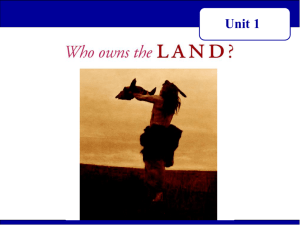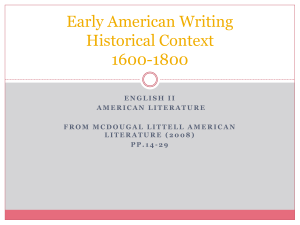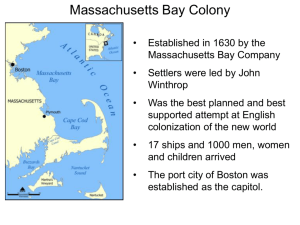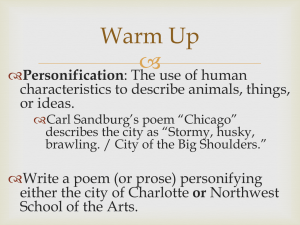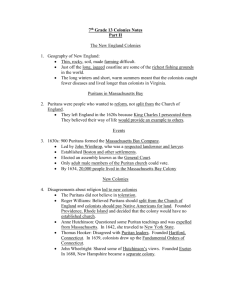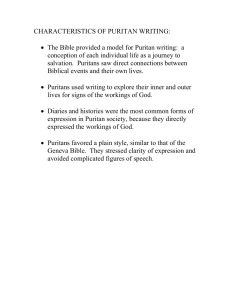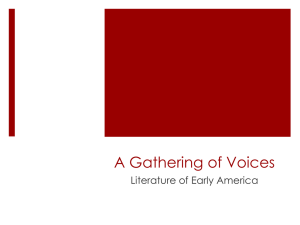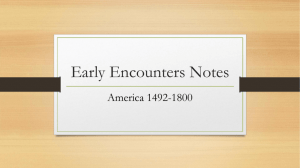Outlining Early American Writing
advertisement
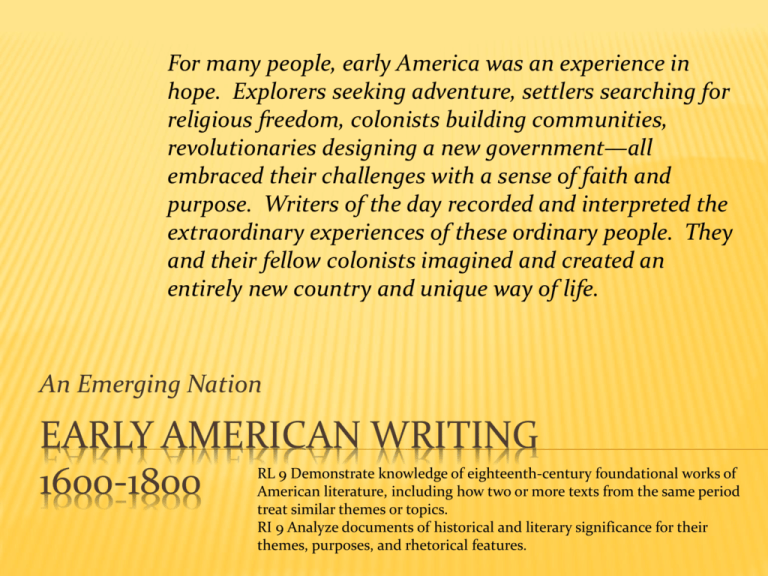
For many people, early America was an experience in hope. Explorers seeking adventure, settlers searching for religious freedom, colonists building communities, revolutionaries designing a new government—all embraced their challenges with a sense of faith and purpose. Writers of the day recorded and interpreted the extraordinary experiences of these ordinary people. They and their fellow colonists imagined and created an entirely new country and unique way of life. An Emerging Nation EARLY AMERICAN WRITING 1600-1800 RL 9 Demonstrate knowledge of eighteenth-century foundational works of American literature, including how two or more texts from the same period treat similar themes or topics. RI 9 Analyze documents of historical and literary significance for their themes, purposes, and rhetorical features. WHO OWNS THE LAND? For thousands of years, Native Americans regarded themselves as caretakers, not owners, of the land. The Europeans who began arriving in North America, however, saw things differently. They laid claim to the land and aggressively defended it from Native Americans—and from one another. In the end, the British claim overpowered all others. Yet the question remains: What entitles people to claim land as their own? ARE PEOPLE BASICALLY GOOD? Puritan settlers believed that human beings were sinful creatures doomed to a fiery eternity unless saved by the grace of God. Yet others who came to North America celebrated the powers of reason and proclaimed the goodness and intrinsic worth of humans. Are people destined always to struggle against their basest instincts? Or are they fundamentally good—and capable of becoming even better? THE MEETING OF TWO WORLDS Explorers and early settlers forged a life for themselves in America that was completely foreign to what they had known in their home countries. In fact, so extraordinary were their experiences that the earliest American writers concentrated mainly on describing and trying to make sense out of their challenging new environment and the unfamiliar people with whom they shared it. In diaries, letters, and reports back home, they recorded a historical turning point: when the world of the Europeans first intersected with that of the Native Americans. Unknown to Europeans, people had been living in the Americas for at least tens of thousands of years, adapting to its diverse environments, forming communities, establishing trading networks, and building working cities. Millions of people lived in the Americas on the eve of the arrival of the Europeans—as many as lived in Europe at the time. The earliest writers chronicled how the Europeans and Native Americans viewed one another and the North American land. In 1634, for example, William Wood of Massachusetts Bay Colony noted that the Native Americans “took the first ship they saw for a walking island, the mast to be a tree, the sail white clouds.” William Bradford, governor of Plymouth Plantation, in turn described North America as “a hideous and desolate wilderness, full of wild beasts and wild men.” The land, however, was neither desolate nor hideous, and the Native Americans were usually cooperative—at least until they began to be forced off their land by European colonists. FROM COLONY TO COUNTRY The first permanent colony was established at Jamestown in 1607. By 1733, English colonies stretched all along the Atlantic coast. Once rooted in North American soil, the colonies became increasingly self-reliant and practiced local selfrule. Outlining Early American Writing I. Historical Context A. The Meeting of Two Worlds 1. Early writers described land and people. 2. Native Americans had well established communities when Europeans arrived. 3. Writers chronicled Native American and European views of one another. B. From Colony to Country 1. First colony at Jamestown 1607 LOYALTY TO LONDON The first colonists thought of themselves as English subjects, even though they did not have representatives in the British parliament. They supported England economically by exporting raw materials to the homeland and importing Britain’s manufactured goods. Britain, in turn, protected its territory. It sent soldiers to fight during the French and Indian War (1759–1763), when France allied with a number of Native American groups to drive the British out of North America. After many defeats, England brought in new military leaders and made its own alliance with Native Americans—the powerful Iroquois. After a long and costly war, the victorious Great Britain claimed all of North America east of the Mississippi River. A BREAK WITH ENGLAND British parliament imposed the Stamp Act and the Tea Act to gain revenue from the colonies. Instead, these acts incited revolt. The Boston Tea Party was but one of many skirmishes leading to the Revolutionary War. When Great Britain tried to tax the colonists to recover some of the money spent on the war, however, it ended up losing far more than its war costs. Fired by cries of “No taxation without representation,” the colonists protested British control—in both fiery words and bold actions. With each new act of British “tyranny,” writers for colonial newspapers and pamphlets stirred the hearts and minds of the colonists to support independence. The colonies declared themselves to be “free and independent” in 1776 and fought and defeated one of the greatest military powers on earth to turn their declaration into a reality. The remarkable minds of Benjamin Franklin, Thomas Jefferson, and other colonial thinkers put timeless words to this experiment in the form of the Declaration of Independence and the Constitution of the United States. When the Constitution was approved in 1788, the United States of America was born. CULTURAL INFLUENCES Religion was the most influential cultural force on writers of this period. Puritan values and beliefs directed people’s everyday lives as well as the formation of an American society. PURITAN BELIEFS Many of the settlers in the 1600s were Puritans. Puritans were a group of English Protestants who had sought to “purify” the Church of England and return to simpler ways of worshiping. Their efforts had been most unwelcome in England, however, and many left the country for America to escape persecution. Puritan settlers believed themselves chosen by God to create a new order in America. John Winthrop, for example, wrote in 1630 that “we must consider that we shall be as a City upon a hill. The eyes of all people are upon us.” Puritans’ values directed every aspect of their lives. They saw human struggle with sin as a daily mission and believed, above all else, that the Bible would help them through the torments of human weakness. Although they felt that humans were essentially sinful, they believed that some, the “elect,” would be spared from eternal punishment by God’s grace. Hard work, thrift, and responsibility were therefore seen as morally good, a sign that God was working within. The thriving settlements and financial success that grew from these qualities were thought to be a mark of God’s approval. However, Puritanism had a dark side as well. Puritans tended to be inflexible in their religious faith and intolerant of viewpoints other than their own. In one famous case, the Salem witchcraft trials, a whole community fell victim to the hysteria of the witch-hunt, ending with more than 20 people dead by execution. IDEAS OF THE AGE In the 1700s, both Enlightenment ideals and Puritan values contributed to the country’s thirst for independence. A Voice from the Times We hold these truths to be self evident, that all men are created equal, that they are endowed by their Creator with certain unalienable Rights, that among these are Life, Liberty, and the pursuit of Happiness. —Thomas Jefferson from the Declaration of Independence THE ENLIGHTENMENT In the 1700s, there was a burst of intellectual energy taking place in Europe that came to be known as the Enlightenment. Enlightenment thinkers had begun to question previously accepted truths about who should hold the power in government. Their thinking pointed the way to a government by the people—one in which people consent to government limitations in exchange for the government’s protection of their basic rights and liberties. American colonists adapted these Enlightenment ideals to their own environment. The political writings of Benjamin Franklin, Thomas Paine, and Thomas Jefferson shaped the American Enlightenment and began to eclipse even the most brilliant European thought. Enlightenment ideals prompted action and gave colonists a philosophical footing for their revolution. “I know not what course others may take,” Patrick Henry thundered to the delegates at the second Virginia Convention in 1775, “but as for me, give me liberty, or give me death!” THE GREAT AWAKENING At the same time, many people began to worry that Puritan values were being lost. Preachers such as Jonathan Edwards called for people to rededicate themselves to the original Puritan vision, and a new wave of religious enthusiasm began to rise. This movement, called the First Great Awakening, united colonists who were in other ways diverse. Across the colonies, people began to feel joined in the belief that a higher power was helping Americans set a new standard for an ethical life. While the Enlightenment and the Great Awakening emphasized opposing aspects of human experience—reason and emotionalism, respectively— they had similar consequences. Both caused people to question traditional authority, eventually leading colonists to break from Britain’s control and embrace democracy. EARLY AMERICAN LITERATURE Early American writing is as varied as early Americans themselves. Native Americans, explorers, settlers, and revolutionaries all contributed their own perspectives to our knowledge of this literary period. THE NATIVE AMERICAN EXPERIENCE When the Europeans arrived, there were more than 300 different Native American cultures in North America with strongly differing customs and about 200 different languages spoken. Yet wherever they lived—in the smoky longhouses of the Northeastern woodlands, the well-defended cliff dwellings of the desert Southwest, the cedar-scented lodges of the Pacific Northwest—one activity was common to all: storytelling. The Native North American cultures did not have a written language. Instead, a group’s history, legends, and myths were entrusted to memory and faithfully passed from generation to generation through oral tradition. In the words of one Native American holy woman, “When you write things down you don’t have to remember them. But for us it is different. . . . [A]ll that we are, all that we have ever been, all the great names of our heroes and their songs and deeds are alive within each of us. . . living in our blood.” This modern depiction of a Haida creation story shows the Raven (a popular cultural hero in many Native American myths and legends) opening a shell to release the first humans into the world. THE NATIVE AMERICAN LITERARY STYLE The forms of Native American oral literature are rich and varied. Creation stories, ways to explain how the universe and humans came into being, can be found in every Native American culture. Other forms include legendary histories tracing the migration of peoples or the deeds of great leaders, fairy tales, lyrics, chants, children’s songs, healing songs, and dream visions. Tragically, much of this literature did not survive after so many Native Americans fell to European diseases. Some groups lost as many as 90 percent of their people, all of whom had a share in preserving the traditional stories. The surviving works, however, show that diverse Native American groups explored common themes in their spoken literature, including a reverence for nature and the worship of many gods. EXPLORATION AND THE EARLY SETTLERS While Native American literature offers us a glimpse into the ways and values of America’s indigenous peoples, much of our understanding of pre-colonial America comes from the first-person accounts of its early explorers, settlers, and colonists. The journals, diaries, letters, logs, and historical narratives of those first Europeans to view the American landscape describe in vivid detail its many sights and wonders, as well as its dangers and challenges. EARLY SETTLERS The early English settlers described their difficult and amazing new lives in letters, reports, and chronicles to friends and family back home. Their writings helped people in England imagine what life might be like in America. One of the most influential writings was A Brief and True Report of the New Found Land of Virginia, by Thomas Harriot, which faithfully captured the area’s natural resources, the ways of life of the Native Americans, and the potential for building a successful colony. It was published in 1588 and was accompanied by illustrations that helped thousands upon thousands of English readers form their first clear picture of North America. COLONIAL HISTORIES As the colonies took root, writing began to focus less on pure description and more on the story of the growth of the colonies. In contrast to the carefully accurate Harriot, for example, Captain John Smith wrote sometimes-embroidered accounts of the history of Virginia and New England. By force of his vivid and engaging writing, he created an enduring record of life in the early colonies and an intriguing selfportrait of a man proud of his great deeds and eager to gain recognition. His accounts were also instrumental in attracting settlers to Virginia, thus ensuring the eventual success of that colony. THE PURITAN TRADITION Puritan writers had their own purposes for recording history. They believed writing should be useful, a tool to help readers understand the Bible and guide them in their daily lives. For this reason, logic, clarity, and order were more prized in writing than beauty or adornment. One Puritan compared adorned writing to stained-glass windows. “The paint upon the glass may feed the fancy, but the room is not well lighted by it.” Using a familiar, down-to-earth metaphor such as this to make a deeper point is a common feature of Puritan writing. The direct, powerful, plain language of much of American literature owes a debt to the Puritans. SERMONS AND OTHER WRITINGS The works of Puritan writers, such as Cotton Mather and Jonathan Edwards, include histories of the colonies and fiery sermons on the dangers of sinful ways. Along with histories and sermons, Cotton Mather chronicled the disturbing Salem witch trials, where 20 people were condemned to death in an atmosphere of mass hysteria. He also wrote about scientific matters, including inoculation for smallpox. Like Mather, Jonathan Edwards wrote on a variety of subjects, including the flying (or ballooning) spiders he had observed as a boy. His account of these spiders is considered the first natural history essay on that subject. PURITAN POETRY Most Puritan writers composed “plain” sermons, histories, and treatises, but poetry was the means of expression for others. In fact, the first book issued in the North American colonies was the Bay Psalm Book in 1640, in which the Bible’s psalms were rewritten to fit the rhythms of familiar Puritan hymns. Puritan poets such as Anne Bradstreet and Edward Taylor viewed poetry primarily as a means of exploring the relationship between the individual and God. Bradstreet’s poems reflect her wide learning, deep faith, and love for her husband and children. They also provide insight into the position of women in the male dominated Puritan society. Her book of poetry, The Tenth Muse Lately Sprung Up in America (1650), was the first work by a North American woman to be published. Minister Edward Taylor, possibly considered the best-known Puritan poet, wrote most of his poems as aids for his meditations. His poetry, like much Puritan writing, uses vivid images from nature and from everyday life as a way to help readers grasp the spiritual world beyond. Evangelical preacher George Whitefield was a key figure in the revival movement of America’s “Great Awakening.” WRITERS OF THE REVOLUTION It is curious to consider now, but some of the most famous figures of the American Revolution lived at the same time as Puritans such as Jonathan Edwards. As products of the Enlightenment, however, revolutionary writers focused their energies on matters of government rather than religion. A Voice from the Times These are the times that try men’s souls: The summer soldier and the sunshine patriot will, in this crisis, shrink from the service of his country; but he that stands it NOW, deserves the love and thanks of man and woman. —Thomas Paine from The Crisis For Your Notes writers of the revolution PAMPHLETS AND PROPAGANDA Many of the gifted minds of this period were drawn to political writing as the effort to launch a grand experiment in government took shape in North America. The most important outlet for the spread of these political writings was the pamphlet. Between 1763 and 1783, about two thousand pamphlets were published. These inexpensive “little books” became the fuel of the revolution, reaching thousands of people quickly and stirring debate and action in response to growing discontent with British rule. Through these pamphlets the words that would define the American cause against Great Britain became the currency of the day, and the debate about independence grew louder and louder. One such pamphlet, Common Sense, by Thomas Paine, helped propel the colonists to revolution. Though expressing the views of the rational Enlightenment, Paine also agreed with the Puritan belief that America had a special destiny to be a model to the rest of the world. At the end of his stirring essay, he says that freedom had been hunted down around the globe and calls on America to “receive the fugitive,” to give freedom a home, and to welcome people from around the world to its free society.
